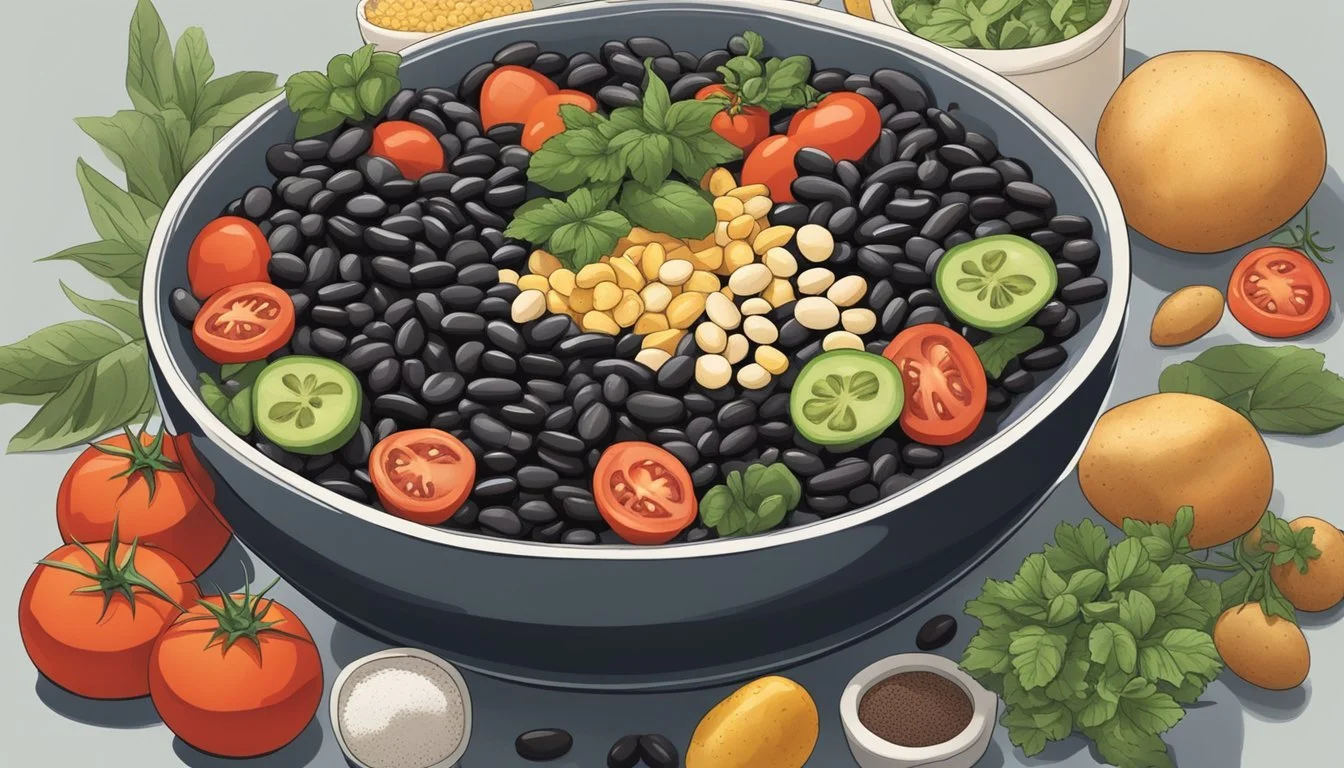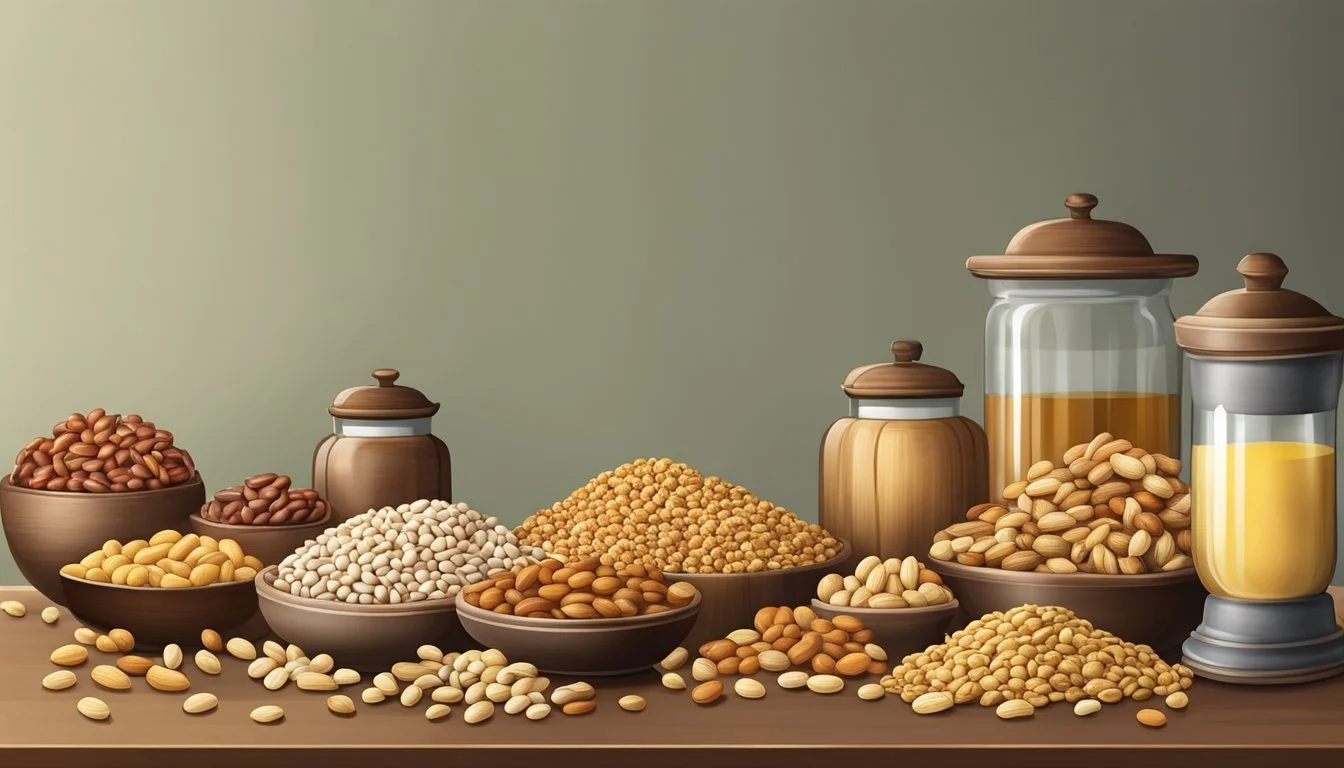Common Foods High in Lectins
Common Ingredients to Avoid
Lectins, a type of protein found in many plants, have garnered attention for their potential impact on human health. Some believe that these proteins can interfere with the digestive process and contribute to inflammation and other health concerns. This article aims to highlight which foods are known to be high in lectins.
Understanding which foods contain high levels of lectins can help individuals make informed dietary choices. For those looking to manage their lectin intake, this list provides a useful starting point. By being aware of these foods, readers can better decide how to incorporate or avoid them in their diet.
1) Kidney Beans
Kidney beans are a popular component in many cuisines and are known for their high nutritional value. They are rich sources of protein and fiber, making them a staple in vegetarian and vegan diets.
Raw or undercooked kidney beans contain high levels of phytohemagglutinin, a type of lectin that can be toxic. To minimize this risk, it's essential to cook kidney beans thoroughly. Soaking the beans for several hours and then boiling them can effectively reduce the lectin content to safe levels.
Kidney beans are often used in chili, soups, and stews. Using a pressure cooker can further ensure the reduction of lectins, making the beans safer to eat. When prepared correctly, kidney beans offer a nutritious addition to a balanced diet.
2) Black Beans
Black beans are popular in many cuisines, notable for their rich taste and high nutrient content. They are a significant source of plant-based protein, fiber, and essential minerals like iron and magnesium.
Despite their nutritional benefits, black beans contain lectins, natural proteins that can interfere with digestion. Consuming raw or improperly cooked black beans may cause gastrointestinal distress due to these lectins.
Cooking black beans thoroughly is crucial to reduce lectin levels. Methods such as boiling or pressure-cooking can effectively neutralize lectins, making black beans safe to eat.
Sprouting and fermenting black beans are additional techniques to lower lectin content. These processes enhance digestibility and may improve nutritional absorption.
Heavily utilized in vegetarian and vegan diets, black beans offer versatility in various dishes. Their lectin content should be acknowledged, but proper preparation can mitigate potential issues. Thus, incorporating black beans into meals need not be problematic when handled correctly.
3) Soybeans
Soybeans are a well-known source of lectins, which make up about 10% of their protein content. This high lectin content is a key consideration for those monitoring their intake for health reasons. Soybeans are commonly used in various forms such as tofu, tempeh, and soy milk.
Cooking soybeans thoroughly can significantly reduce their lectin levels. Methods like boiling and fermenting are effective in breaking down lectins. For example, traditional tempeh production can reduce lectins by up to 95% through fermentation.
Despite their lectin content, soybeans are also rich in essential nutrients. They provide a substantial amount of protein, vitamins, and minerals, making them a popular choice among vegetarians and vegans. This nutritional benefit often outweighs concerns for those who do not have specific sensitivities to lectins.
Soybean products vary in their lectin content based on how they are processed. Fermented soy products like tempeh and miso typically have lower lectin levels compared to raw or minimally processed soybeans. This makes fermented products a preferable option for individuals aiming to minimize lectin intake.
4) Lentils
Lentils are known for their high nutritional value, providing a rich source of protein, fiber, and essential minerals. They are particularly popular in plant-based diets.
Lentils contain a significant amount of lectins, especially when raw. These lectins can pose digestive issues if not properly managed. However, cooking lentils thoroughly deactivates most of these lectins, making them safe to consume.
Various types of lentils, including green, red, and black, can be incorporated into soups, stews, and salads. Each variety offers a unique texture and flavor profile.
Including lentils in your diet can support regular bowel movements and promote gut health due to their high fiber content. They are also a good source of potassium, zinc, copper, and manganese.
5) Tomatoes
Tomatoes are widely consumed and favored for their culinary versatility. They belong to the nightshade family and are known for containing lectins, particularly in their skin and seeds.
To reduce lectin content, some recommend peeling and deseeding tomatoes. This process may be beneficial for those sensitive to lectins, allowing them to enjoy tomatoes with fewer digestive concerns.
Despite their lectin content, tomatoes are nutrient-dense. They are rich in vitamins A and C, potassium, and antioxidants like lycopene. These nutrients contribute to heart health, skin health, and lower inflammation.
Cooking tomatoes can also impact their lectin levels. Exposure to heat can reduce the activity of lectins, making cooked tomatoes potentially less problematic for those with sensitivities.
Though containing lectins, many people can still consume tomatoes without any adverse effects. Balancing their inclusion in the diet with other foods can help mitigate potential digestive issues.
6) Peanuts
Peanuts are a common source of lectins, naturally occurring proteins that bind to carbohydrates. These proteins play a defensive role for plants, safeguarding them against various pests and pathogens.
Despite their nutritional benefits, lectins in peanuts can pose digestive issues for some individuals. Consuming raw peanuts may lead to gastrointestinal discomfort due to the presence of active lectins.
Roasting or boiling peanuts can significantly reduce their lectin content. This process makes them safer for consumption and can mitigate potential adverse effects.
Peanuts are also rich in essential nutrients like protein, healthy fats, and vitamins. They are a popular snack and ingredient in many culinary dishes.
For those sensitive to lectins, moderating peanut intake or opting for processed forms can be beneficial.
7) Wheat
Wheat is a staple grain found in many diets around the world. It is a significant source of lectins, particularly in its raw form. Lectins are proteins that can bind to carbohydrates and may cause various health issues when consumed in large amounts.
The lectin content in wheat can affect the intestinal wall, potentially leading to digestive problems. Some studies have shown that lectins in wheat may contribute to the breakdown of the proteins that hold the cells of the intestinal wall together.
Cooking wheat thoroughly can reduce the lectin content to safer levels. Processes such as sprouting and fermenting can also lower the levels of lectins, making the wheat more digestible and less likely to cause adverse effects.
8) Eggplants
Eggplants are a notable member of the nightshade family and are known for their rich lectin content. These lectins are most concentrated in the seeds and skin of the vegetable.
Despite their lectin content, eggplants are widely consumed around the world. They are versatile, being used in dishes from moussaka to ratatouille.
Cooking methods can influence the lectin levels in eggplants. By thoroughly cooking or fermenting them, it's possible to reduce the potential negative effects associated with lectins.
Some individuals might experience digestive discomfort when consuming eggplants due to these lectins. Those following a lectin-free diet should consider avoiding or properly preparing eggplants to minimize any possible adverse effects.
9) Bell Peppers
Bell peppers are a common member of the nightshade family, known for their vibrant colors and sweet taste. They contain lectins, which are proteins that can bind to carbohydrates.
Most of the lectins in bell peppers are located in their seeds and the white pith inside the pepper. It's important to note that cooking can reduce the lectin content, making them less of a concern for those sensitive to lectins.
Bell peppers are rich in vitamins A and C, making them a nutritious addition to many diets. Despite their lectin content, they offer numerous health benefits when properly prepared and consumed in moderation.
For individuals who are particularly sensitive to lectins, removing the seeds and cooking the bell peppers thoroughly might help mitigate any potential adverse effects.
10) Goji Berries
Goji berries are popular for their purported health benefits and high nutrient content. Packed with vitamins, minerals, and antioxidants, they are often marketed as a superfood.
Despite their nutritional benefits, goji berries are high in lectins. Lectins are plant proteins that some believe can cause digestive issues and other health problems by binding to cell membranes.
Dr. Steven Gundry suggests avoiding goji berries for those following a lectin-free diet. According to his recommendations, their lectin content may contribute to gut irritation and inflammation.
Goji berries also belong to the nightshade family, which includes other high-lectin foods such as tomatoes, potatoes, and eggplants. Nightshade plants are known for containing not only lectins but also glycoalkaloids, compounds that can be harmful in large quantities.
For those sensitive to lectins, consuming goji berries might lead to digestive discomfort. Reducing or eliminating these berries from the diet could mitigate these adverse effects.
In the context of a lectin-free diet, it is important to carefully evaluate the inclusion of goji berries. Their high lectin content and potential for causing gut issues make them a controversial choice.
Understanding Lectins
Lectins are proteins found in many foods that can have significant effects on your body, particularly the digestive system. Learning about what lectins are, how they interact with your body, and where they are commonly found is crucial for making informed dietary decisions.
What Are Lectins?
Lectins are a type of protein that binds to carbohydrates.
They play a role in plant defense mechanisms, deterring pests and pathogens. Lectins are known for their ability to resist digestion and attach to cell membranes, which can sometimes lead to adverse health effects.
Found in various plant-based foods, lectins have garnered attention for their potential anti-nutrient properties. Some lectins can interfere with nutrient absorption and gastrointestinal health. However, not all lectins are harmful, and their effects can be mitigated through proper food preparation methods such as cooking, soaking, or fermenting.
How Lectins Affect the Body
Lectins can impact the body in several ways.
When consumed in high quantities or in an improperly prepared state, lectins may cause digestive issues. These proteins can bind to the lining of the gastrointestinal tract, which may contribute to symptoms like bloating, gas, and discomfort.
In some cases, lectins can interfere with the absorption of essential nutrients, leading to nutrient deficiencies. Potential health concerns also include triggering autoimmune responses in sensitive individuals, exacerbating conditions like leaky gut syndrome.
Proper food preparation techniques, such as cooking beans thoroughly, can deactivate most lectins, making them safe to eat.
Common Sources of Lectins
Lectins are prevalent in many common foods.
Legumes: Beans, lentils, and peas are particularly high in lectins. Eating raw or undercooked kidney beans, for instance, can lead to severe digestive trouble.
Nightshades: This food group includes tomatoes, eggplants, peppers, and potatoes. These vegetables contain varying levels of lectins, especially in their skins and seeds.
Grains and Seeds: Wheat, barley, and other whole grains, as well as seeds like quinoa, also contain lectins.
Preparation methods such as cooking, sprouting, and fermentation can significantly reduce lectin levels in these foods, making them safer and more digestible.
Health Implications of Lectins
Lectins are naturally occurring proteins found in many plants and animals. Their health implications depend significantly on whether they are consumed in cooked or raw forms.
Potential Benefits
Lectin-containing foods, such as beans, whole grains, and nuts, are associated with various health benefits. They may contribute to lower rates of Type 2 diabetes and cardiovascular diseases due to their nutrient-rich profiles.
Studies suggest that these foods can enhance gut health by promoting beneficial bacterial growth. Additionally, the fiber in lectin-rich foods aids in digestion and helps maintain stable blood sugar levels.
Research has indicated that the beneficial effects of lectins in moderation can be substantial. This is particularly true when they are part of a balanced diet, comprising processed and cooked foods.
Potential Risks
Raw or undercooked foods high in lectins, like kidney beans, can be harmful. They contain phytohemagglutinin, which may cause gastrointestinal distress, including nausea, vomiting, and diarrhea.
Certain lectins have been implicated in chronic inflammation and autoimmune reactions. For sensitive individuals, foods such as tomatoes, eggplants, and peppers might exacerbate these conditions.
Consuming high amounts of raw lectins may impair nutrient absorption. They can bind to the lining of the gastrointestinal tract, potentially blocking the assimilation of essential minerals.
Thorough cooking and processing degrade lectins, reducing their potentially harmful effects considerably. Thus, consuming well-prepared foods minimizes associated risks.
Cooking and Preparation Tips
Proper cooking and preparation can help reduce the lectin content in foods significantly. Methods like soaking, fermenting, peeling, and pressure-cooking are effective in minimizing lectins.
Methods to Reduce Lectin Content
Soaking: Soaking beans and legumes in water for several hours or overnight can help decrease their lectin content. This process allows lectins to leach out into the soaking water, which should be discarded before cooking.
Fermentation: Fermenting foods such as vegetables and grains can help break down lectins. Fermentation uses beneficial bacteria that naturally reduce harm by targeting lectin proteins.
Peeling and Deseeding: Many lectins are concentrated in the skins and seeds of fruits and vegetables. By peeling and deseeding items like tomatoes, cucumbers, and squash, one can significantly lower their lectin content.
Pressure-Cooking: This method is particularly effective for beans and legumes. Pressure-cooking at high temperatures can break down lectins more efficiently than other cooking methods. This ensures that foods like kidney beans are safe to eat.
Examples of Lectin-Reducing Techniques
Beans and Legumes: Soak these in water for 8-12 hours before cooking. After soaking, make sure to rinse thoroughly. Then, use a pressure cooker to cook for at least 30 minutes to ensure the lectins are destroyed.
Nightshades (e.g., Tomatoes and Peppers): Peeling and deseeding can be effective. Blanch tomatoes in boiling water for a minute, then transfer to ice water. The skins will peel off easily, and seeds can be removed with a spoon.
Grains: Fermenting grains like wheat and rye can decrease lectin content. Sourdough bread, for example, undergoes a fermentation process that breaks down some of the lectins.
Cucurbits (e.g., Cucumbers and Squash): Remove both skins and seeds. Use a peeler for the skin and a spoon for the seeds. This reduces lectins significantly because they are concentrated in these parts.








